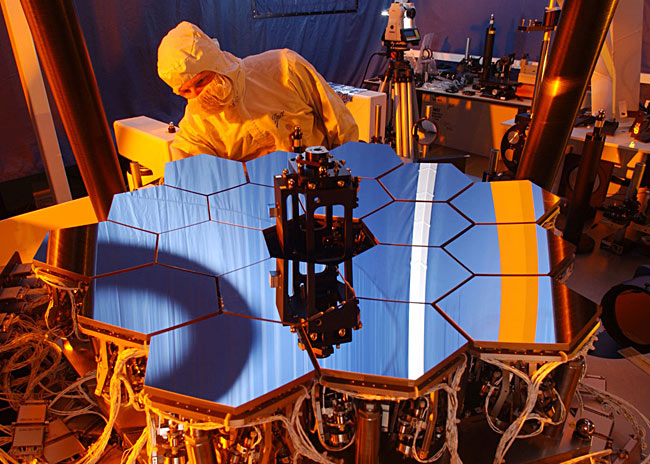NASA's Next Big Space Telescope Passes Brain Test

Engineershave successfully tested the mirror-controlling "brain" of the JamesWebb Space Telescope (JWST), which is expected to rival imagery taken by theHubble Space Telescope.
Thesoftware, known as Wavefront Sensing and Control (WFSC), will allow theWebb telescope to adjust its 18 hexagonal mirrors.
"It'scritical that all 18 mirror segments be aligned in position so that they act asone smooth surface," said Bill Hayden, a systems engineer at NASA'sGoddard Space Flight Center (GSFC) in Greenbelt, Md. "This will allowscientists to clearly focus on very dim objects that we can't see now."
JWST isslated for launch in 2013.
Hubblerival
With acombined mirror surface of 269 square feet (25 square meters), the Webbtelescope will have nearly six times the light-gathering ability of HubbleTelescope, which has one giant 46-square-foot (4.3-square-meter) mirror.Astronomers expect such sensitivity to allow them to see the first stars andgalaxies of the universe as well as young planetary systems.
The Webbtelescope will launch in a folded-up configuration, later unfurling itslightweight beryllium mirrors in orbit one million miles (1.6 millionkilometers) from Earth. Unadjusted, however, the Webb telescope's mirrors wouldproduce blurry images like Hubble did when it first peered into the cosmos.
Get the Space.com Newsletter
Breaking space news, the latest updates on rocket launches, skywatching events and more!
David L.Taylor, president and chief executive officer of Ball Aerospace &Technologies Corp., said WFSC software that will prevent the problem is basedon the same code used to fix the Hubbletelescope's imperfections.
"Thismajor technological accomplishment, which built on the legacy of software algorithmsused to fix the Hubble Space Telescope and align the Keck telescope," saidJohn Mather, the Webb telescope's senior project scientist at GSFC.
Mini-Webb
To test theWFSC software, engineers created a one-sixth scale model of the Webb telescopemodel in the laboratory. Once in space, the real 6.2-ton (13,700-pound)telescope will snap a picture of the cosmos, run the software correlating the18 different light sources (its mirrors) and then correct them using tinymotors.
In thequarterly newsletter issued by the Webb telescope's scientists, Hayden said thetesting isn't fully complete, but should go forward without a hitch.
"Thetests started in mid-October and will finish by early December," Haydensaid, adding that recent results suggest final testing "will be verysuccessful."
Webbtelescope scientists presented their mirror-adjusting work on Aug. 26 at theSociety for Photo-Optical Instrumentation Engineers meeting in San Diego, Calif.
- VOTE: The Best Hubble Images
- NASA Delays JWST by 2 Years
- All About Telescopes
Join our Space Forums to keep talking space on the latest missions, night sky and more! And if you have a news tip, correction or comment, let us know at: community@space.com.
Dave Mosher is currently a public relations executive at AST SpaceMobile, which aims to bring mobile broadband internet access to the half of humanity that currently lacks it. Before joining AST SpaceMobile, he was a senior correspondent at Insider and the online director at Popular Science. He has written for several news outlets in addition to Live Science and Space.com, including: Wired.com, National Geographic News, Scientific American, Simons Foundation and Discover Magazine.









